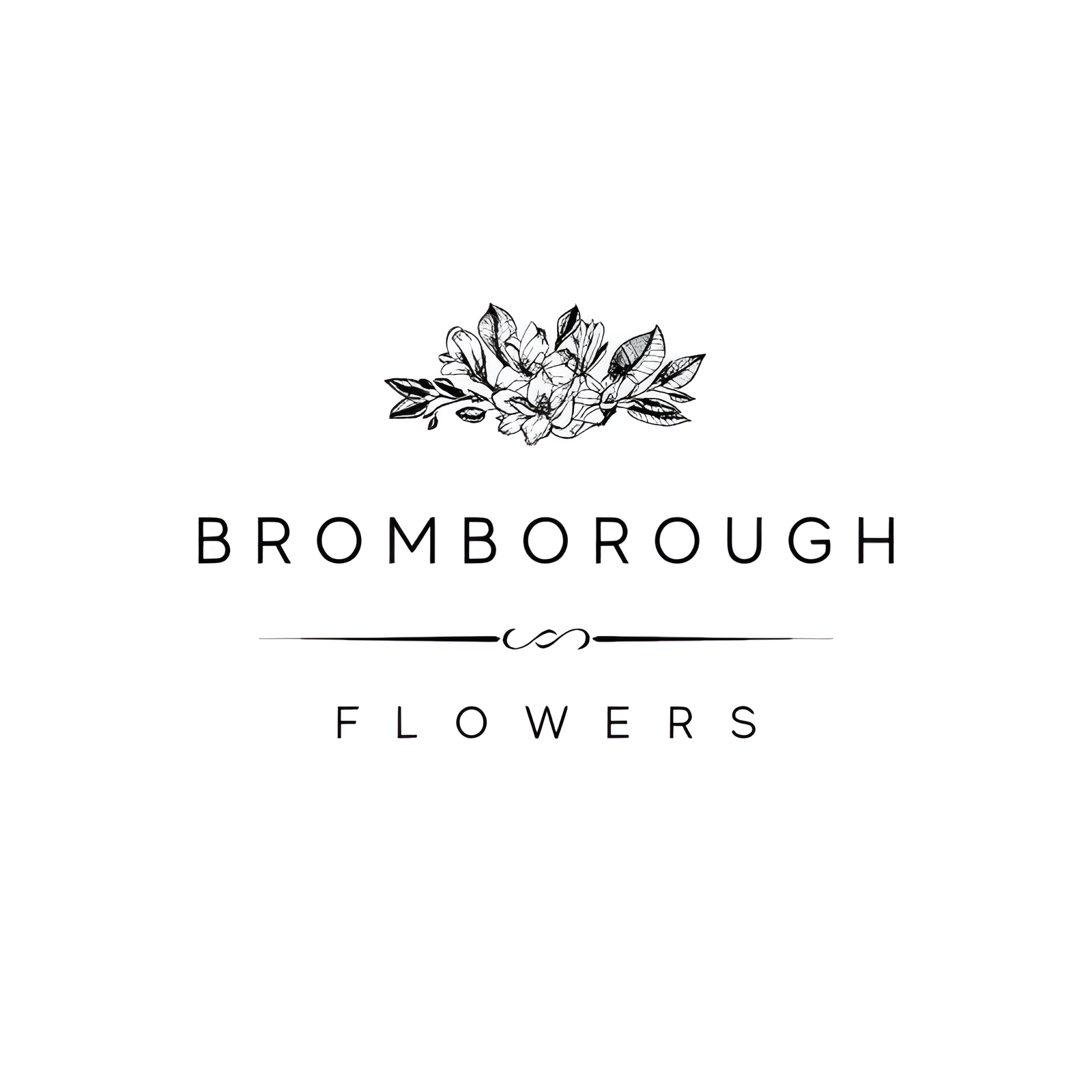Lavender, with its enchanting purple hues and soothing fragrance, stands as a quintessential choice for wedding florals, offering both aesthetic appeal and symbolic depth. This versatile flower represents love, purity, and serenity, making it an ideal addition to various wedding elements, from bridesmaid bouquets to table centerpieces. Its long, slender stems and fragrant blooms lend an air of elegance and natural charm to any ceremony. Yet, beyond its immediate visual and olfactory appeal, there’s much more to uncover about lavender’s rich cultural significance and practical applications in wedding planning.
Flower Overview
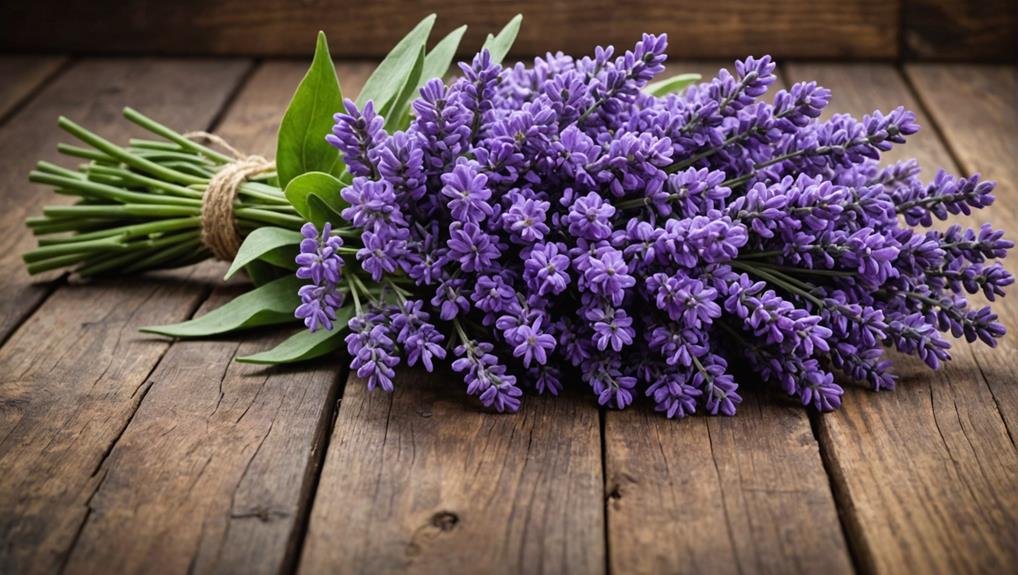
Lavender, renowned for its soothing scent and enchanting purple blooms, is a multifaceted flower ideal for wedding arrangements. Its calming fragrance and symbolic meanings of love, devotion, purity, and serenity make it a favored choice for couples looking to infuse their special day with a touch of natural elegance. Lavender‘s versatility allows it to be seamlessly incorporated into various wedding elements, enhancing the overall aesthetic.
One of the most popular applications of lavender in weddings is in bridesmaid bouquets. These bouquets, often designed to complement the bride’s own floral arrangement, benefit immensely from the inclusion of lavender. The flower’s delicate purple hue provides a striking contrast against traditional white or pastel bridal gowns, adding a layer of visual interest and cohesion to the bridal party’s appearance. Additionally, the fragrant blooms contribute a subtle, calming aroma that can help ease pre-ceremony jitters for both the bride and her attendants.
Lavender’s budget-friendly nature further enhances its appeal, allowing couples to achieve a romantic and whimsical ambiance without excessive costs. Whether used alone or combined with other flowers, lavender’s presence in bridesmaid bouquets and other arrangements creates a charming and cohesive wedding aesthetic.
Physical Description
Characterized by small, fragrant blooms that appear in shades of purple, lavender, and white, the physical attributes of lavender enhance its appeal in wedding arrangements. The flowers are known for their pleasant aroma, which adds a sensory dimension to any Lavender Wedding.
Each bloom is complemented by narrow, needle-like leaves, which provide a striking contrast to the delicate petals. These flowers are borne on long, slender stems, making them ideal for creating elegant bridal bouquets and other floral arrangements.
Lavender’s visual charm is matched by its versatility. The long stems allow for a variety of uses, from cascading centerpieces to intricate boutonnières. Their compact size and subtle hues make them perfect for both primary and complementary roles in floral designs, catering to different aesthetic preferences.
The calming properties of lavender’s scent add another layer of appeal, offering a serene and tranquil atmosphere to wedding settings.
Furthermore, lavender’s symbolic meanings of love, devotion, and purity align seamlessly with the themes of a wedding, making it a thoughtful choice for couples. Whether used sparingly or as a focal point, lavender unquestionably contributes to the beauty and emotional resonance of bridal bouquets and wedding decor.
Available Colour Varieties
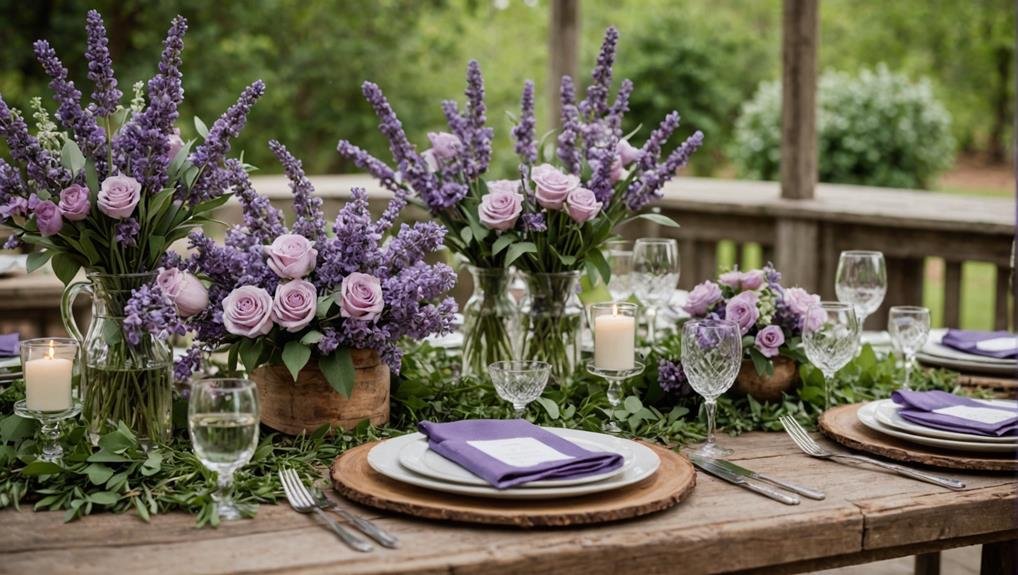
Among the diverse hues available, lavender flowers offer a rich palette of colors that range from light pastels to deep purples, often incorporating subtle hints of blue, pink, or white. This spectrum provides an elegant and versatile choice for wedding floral arrangements.
The classic purple lavender remains a favorite, with its deep, vibrant tones creating a striking visual impact. For those seeking a softer aesthetic, light pastel lavender options provide a delicate touch that pairs beautifully with other blooms. The lavender rose, in particular, is an exquisite choice that blends the timeless elegance of roses with the enchanting hue of lavender. This combination can be complemented by other purple flowers such as carnations and lisianthus, resulting in an arrangement that exudes sophistication.
Beyond the primary shades, lavender flowers can exhibit subtle variations that include tinges of blue, pink, or white, adding depth and complexity to the overall floral design. Pairing these with complementary colors like white, green, silver, or gold can create a cohesive and elegant color palette, perfect for any wedding theme.
The versatility of lavender flowers allows for creative and personalized floral arrangements, ensuring every wedding is unique.
Latin Name and Taxonomy
In botanical terms, the lavender plant is classified under the genus *Lavandula* within the Lamiaceae family. This genus comprises 47 known species, each with unique attributes and aromatic properties. The most commonly known species include *Lavandula angustifolia* and *Lavandula stoechas*. These species are well-regarded for their distinct fragrances and vibrant hues, making them popular choices for wedding florals.
The taxonomy of lavender is intricate, involving various subgenera and sections that help in the accurate classification of its diverse species. This detailed categorization is essential for horticulturists and florists alike, providing a framework to identify and cultivate specific lavender types effectively.
Understanding the Latin name and taxonomy of lavender offers several benefits:
- Accurate Identification: Enables precise recognition of different lavender varieties, ensuring that the right type is selected for specific uses.
- Cultivation Guidance: Assists growers in adopting appropriate cultivation practices tailored to each species’ unique requirements.
- Enhanced Aromatic Qualities: Facilitates the selection of species based on their aromatic profiles, essential for creating the desired ambiance in weddings.
- Aesthetic Appeal: Supports the choice of species with specific color and shape attributes, enhancing the visual elegance of floral arrangements.
This foundational knowledge plays an indispensable role in maximizing the aesthetic and sensory appeal of lavender in wedding decor.
Geographical Origins
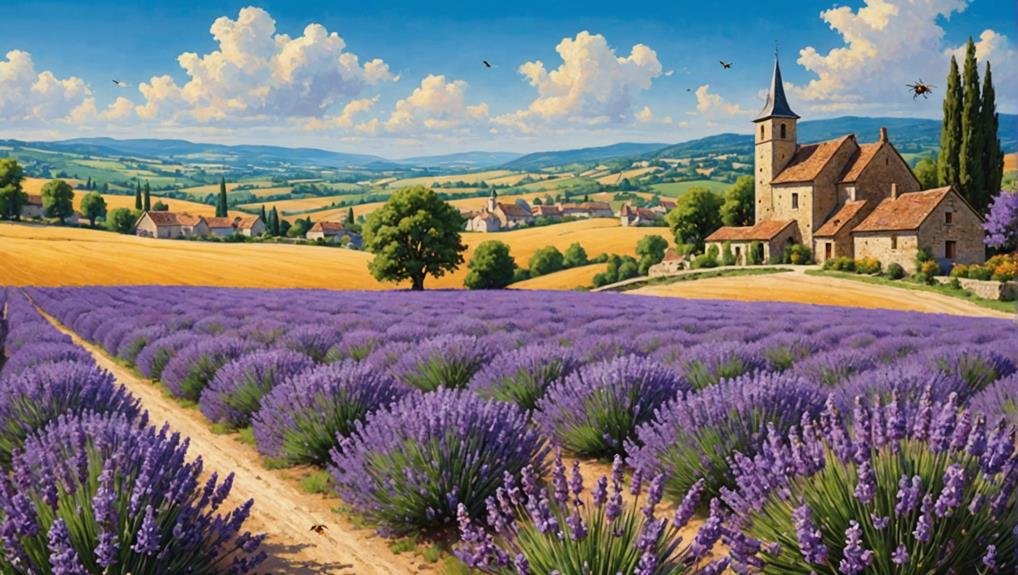
The geographical origins of lavender trace back to the sun-drenched Mediterranean region, particularly the mountainous areas of northern Spain and southern France. This versatile plant thrives in sunny, well-drained soils, making the Mediterranean climate ideal for its cultivation. Lavender’s natural habitat in these regions has led to its widespread use for its fragrant blooms and essential oils, both of which are highly valued.
Varieties such as English lavender and French lavender, each with distinct characteristics and growth habits, underscore the plant’s adaptability. English lavender, typically more compact and hardy, contrasts with the taller, more aromatic French lavender. Both varieties, however, share the symbolic associations of purity, grace, and devotion, attributes that render lavender an excellent choice for weddings.
The delicate beauty of lavender spray roses, often included in bridal bouquets and centerpieces, enhances these symbolic meanings, creating an atmosphere of elegance and romance.
Lavender’s enduring appeal is partly due to its historical and geographical roots, which have shaped its cultural significance. Whether used in cooking, aromatherapy, or as a wedding decoration, lavender’s Mediterranean origins contribute to its timeless charm and versatility.
Season Availability
Lavender flowers typically flourish during the summer months, with peak availability from late June to early August. This season availability makes lavender an ideal choice for summer weddings, adding a touch of sophistication and a calming aroma to your special day.
The warm and sunny conditions that prevail during these months are perfect for lavender to thrive, making certain that you have access to fresh and vibrant blooms.
However, it is important to be mindful that lavender’s availability can vary based on local climate and growing conditions. When planning for lavender flowers, consider the region and climate of your wedding location. This will help you guarantee that the flowers are in their best possible condition for your event.
To evoke a sense of excitement and anticipation for your lavender-filled wedding, consider these key points:
- Seasonal Elegance: Lavender’s peak season offers the most beautiful and fragrant blooms.
- Warm Weather: Ideal summer conditions make lavender a perfect choice for outdoor weddings.
- Regional Variability: Availability can differ based on local climates, so plan accordingly.
- Consult Professionals: Always check with your florist or supplier for specific seasonal variations and availability.
Growing Conditions
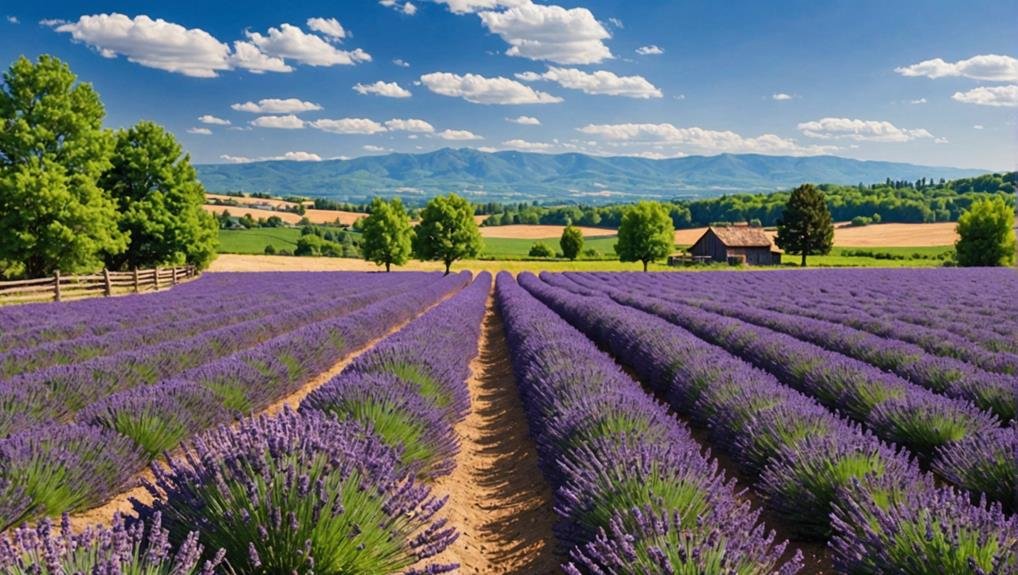
Thriving in full sunlight and well-drained soil, lavender is perfectly suited for gardens and outdoor spaces. This makes it an excellent choice for those looking to cultivate their own wedding flowers. Lavender requires minimal water once established, which is ideal for individuals with busy schedules or those living in drought-prone areas. Its drought-tolerant nature guarantees it remains vibrant and healthy with minimal maintenance.
Lavender’s versatility is further evident in its deer-resistant properties, allowing it to flourish in various climates and landscapes without the worry of local wildlife disturbances. This characteristic is particularly beneficial for those planning outdoor weddings, making sure that the lavender remains pristine and undisturbed. Different varieties of lavender offer a range of heights and bloom colors, providing ample options to complement other popular wedding flowers, such as roses.
Regular pruning after the blooming period is essential to promote new growth and maintain a compact, healthy plant. This practice not only enhances the lavender’s overall appearance but also secures a continuous supply of fresh blooms.
Cultural Significance
Throughout history, lavender’s multifaceted symbolism has made it an integral part of various cultural traditions, representing love, purity, and tranquility. This aromatic herb, renowned for its delicate purple blossoms and soothing scent, has been cherished across civilizations for its wide array of symbolic meanings and practical uses.
In ancient Rome, lavender found its way into bathing rituals, culinary dishes, and medicinal practices, highlighting its versatility and esteemed status. The Victorian era further solidified lavender’s cultural significance by embracing it for its calming properties and as a symbol of devotion and grace. During this period, lavender was often included in wedding bouquets to convey purity and heartfelt commitment.
The cultural significance of lavender extends beyond Europe. Various traditions around the world have incorporated lavender in rituals, ceremonies, and celebrations, underscoring its universal appeal. Lavender’s historical associations with mood enhancement, relaxation, and protection against evil spirits have contributed to its revered status.
Here are four emotional highlights of lavender’s significance:
- Symbol of Love: Lavender in wedding bouquets symbolizes enduring love.
- Purity: Represents innocence and purity in matrimonial ceremonies.
- Tranquility: Promotes a sense of peace and relaxation.
- Protection: Historically believed to ward off negative energies.
In essence, lavender’s enduring cultural significance makes it a cherished choice for wedding bouquets and beyond.
Typical Use in Weddings
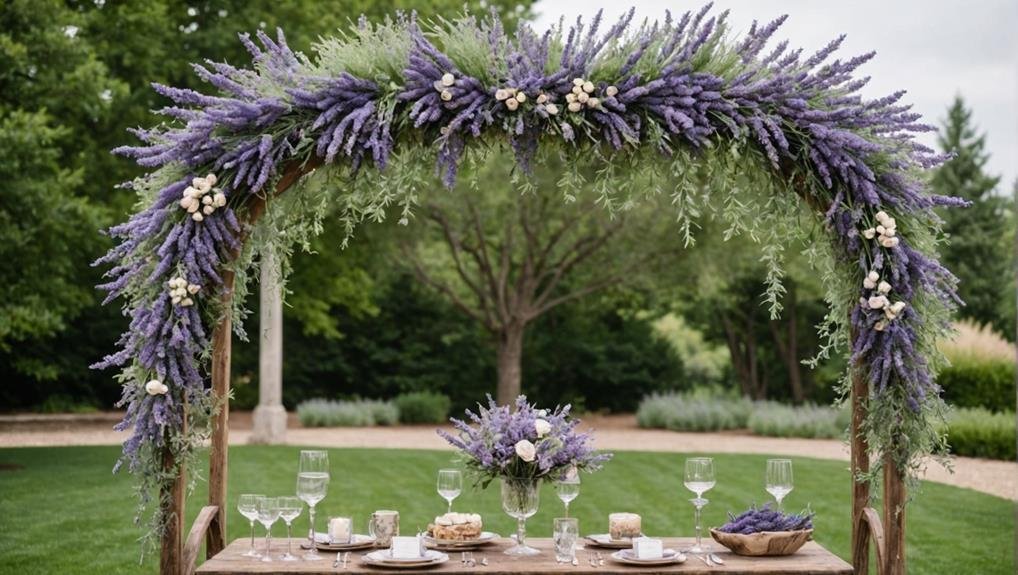
Building on its rich cultural heritage, the use of lavender in weddings has become increasingly popular for its enchanting fragrance and meaningful symbolism. Lavender lends itself beautifully to a variety of wedding elements, enhancing both the aesthetic and sensory experience of the ceremony. The sweet scent and calming ambiance it provides make it a favorite choice for bouquets, boutonnieres, centerpieces, and general decor, adding both elegance and natural charm.
Lavender is often employed in the following ways:
| Wedding Element | Use of Lavender |
|---|---|
| Bouquets | Adds aroma and symbolism of love and purity |
| Boutonnieres | Provides a delightful, aromatic touch for groomsmen |
| Centerpieces | Enhances tables with natural beauty and sweet fragrance |
| Ceremony Backdrops | Creates scenic settings and symbolizes unity |
| Exit Tosses | Offers a scented and memorable send-off for newlyweds |
Incorporating lavender into bridesmaid dresses, hair accessories, stationery, and signage can create a cohesive and refined look that ties the entire wedding theme together. Additionally, lavender’s cost-effective nature makes it an appealing choice for modern weddings. Its versatility and timeless appeal guarantee that lavender remains a popular flower for those seeking to infuse their special day with beauty and serenity.
Alternative Flower Types
To complement lavender in wedding arrangements, consider incorporating alternative flower types such as lisianthus, mini carnations, and ranunculus. These alternatives not only enhance visual appeal but also add texture, color variation, and unique shapes to your bouquets and centerpieces.
Lisianthus, with its delicate petals and romantic appearance, can seamlessly blend with lavender to create a soft and elegant aesthetic. The flower’s subtle charm makes it ideal for more intimate or classic wedding themes.
Mini carnations are another excellent choice, offering a cost-effective option without compromising beauty. Available in a wide range of colors, mini carnations can add vibrancy and diversity to your floral arrangements.
Ranunculus is renowned for its modern and sophisticated look, featuring layered petals that bring an elegant touch to any wedding setting. Its versatility allows it to complement both minimalist and lavish wedding designs. Mixing lavender with these alternative flower types can notably enhance the overall aesthetic, providing depth and richness to your wedding flower designs.
Choosing the right mix of flowers can evoke various emotions and create memorable experiences. Consider the following floral combinations:
- Lavender and lisianthus for a romantic atmosphere.
- Lavender and mini carnations for vibrant, budget-friendly arrangements.
- Lavender and ranunculus for modern elegance.
- A mix of all three for a dynamic and textured bouquet.
